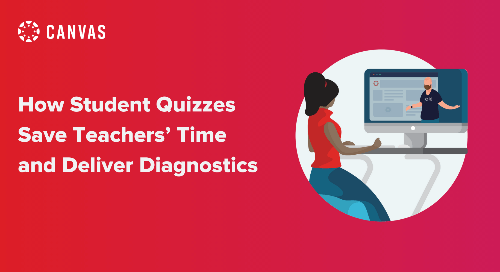Checking students’ understanding on the go—formative assessment —is imperative for educators thanks to the Australian National Curriculum, Australian Professional Standards for Teachers, as well as state and territory education policies.
However, researchers have found there’s “inadequate” support for teachers to implement formative assessment in their classrooms effectively. The sector will benefit from the national Online Formative Assessment Initiative. It’s a high-level, multi-organisational move to hand educators and schools a ‘Teaching Tools Network’ with innovative assessment solutions. Although, as educators know, formative assessment is a process as well as a tool.
Ideally, teachers formally or informally collect and use evidence of their learners’ knowledge and understanding during instruction. Their goals are to use assessment for and as learning to improve student achievement. There’s a nice spinoff for students, too, who learn new skills to reflect on and monitor their progress towards future learning goals.
Teachers are in a tight squeeze—they’re already time-poor. Add to that the pressure to create curriculum-relevant quizzes and other mini-tests, collect and mark them, then if they want to keep the data they would need to manually add that data to the school’s SIS or LMS. It’s too easy for a quality approach to formative assessment to vanish from their lesson plans.
How Formative Assessment Falls Through the Cracks
Teachers face three key challenges preventing them from reflecting on and tweaking their instructional practices to better support their students’ learning, according to research. These challenges are:
- Simplifying formative assessment to a “mechanistic set of procedures and techniques”
- Poor support to connect formative assessment to the curriculum, planning, pedagogy, and learning as a “coherent whole”, and
- Misalignments between the curriculum and the many ways teachers interpret and enact it in their classes.
On that last point, the curriculum isn’t a prescription to be implemented in classrooms. It’s more the ‘what’ not the ‘how’ of teaching and pedagogy. In short, teachers are searching for best practices and an easier way to meet their formative assessment obligations.
That’s why many teachers currently opt for free websites with ready-made quizzes or those they can customise to the content they’re teaching. Often these are great circuit breakers to bring learners back on task when engagement flags.
The Issues with Free Quiz Websites
But those sites could be doing educators and students a disservice.
Consider when teachers press ‘go’ on the free online quiz or game in class. How much of their professional judgement are they using? The quizzes look like ‘busy work’ for students in class yet rarely offer teachers personalised insights into learning. Is there a clear connection with instructional content and strategies? Many sites don’t cater specifically to Australian students, and can be clunky to integrate with the school’s existing LMS, assuming that functionality is even available. Teachers often take to the sites for low-stake polls that don’t push students to think deeply about their learning.
Does the site cumulatively record each student’s results and automatically update the school’s LMS? Or will the teacher have to make a mental note if they don’t get around to doing that extra paperwork? Does the online dashboard deliver real-time diagnostics for the teacher? Will extension students have to wait for others to catch up, or could higher-level work be automatically assigned to fast learners? If the quiz site is free, how cyber secure are student data? And what’s being measured or checked?
Measurement for Meaning
Overall, Australian schools are experiencing an era of metrics, such as the National Assessment Program Literacy and Numeracy (NAPLAN) and the Program for International Student Assessment (PISA). The 2020 student cohort missed NAPLAN due to the pandemic, with much debate about whether it needed to return (it did). The hot topic is how and why student learning could or should be measured. A touchpoint for this discussion is the cut-through mantra ‘if you don’t measure it, you can’t improve it’. The late management consultant, Peter Drucker, coined that.
The notion of measurement is a complex issue. Summative assessment can save time, deliver results, and ensure manageable work hours. However, every student has unique needs, and as such there is no ‘one size fits all’ approach.The issue is measuring not for measurement’s sake, but meaning.
That’s where formative assessment—the most powerful measurement to influence student learning—can shine. And it’s compelling enough for the educational researcher Professor John Hattie to support the Online Formative Assessment Initiative mentioned above.
Hattie’s work draws on 1400 meta-analyses to rank 252 (and growing) influences and effects on student achievement. Top of the list is collective teacher efficacy, which Hattie defines as teachers’ collective belief they can positively affect students. To develop this, teachers use formative assessment, among other approaches. Professional learning, sustained support and the right technology are valuable shortcuts for educators to develop this important attribute.
Formative Assessment: A Teacher’s Superpower?
So, how do effective teachers harness formative assessment?
According to focus area 5.2 of the Professional Teaching Standards, proficient teachers should “provide timely, effective and appropriate feedback to students about their achievement relative to their learning goals”. The ways they can do that are:
- Using entry tickets, a short question or two asking students on arrival to class what they know or remember about a subject from a previous class
- Informally checking in with students individually about their understanding as a teacher moves about in their classroom
- Having students pop a sticky note on their desk with a happy, unsure, or sad face to reveal their progress
- Encouraging students to use each other as peer support to help them learn
- Strategically questioning students individually, in small groups, or as a whole class with hinge questions such as ‘why’ and how’. This triggers higher-order thinking and will earn them more points than simpler questions
- Challenging students to divulge what’s been their “muddiest point” so far in trying to understand the topic
- Getting students to summarise a topic in a sentence, then a paragraph, then two-to-three paragraphs, such as via Twitter, if your school allows it
- Posting a question to the class for a mini-session of think-pair-share, then bring the class back together to do a round-robin to discuss
- Running a silent poll using an app on their devices
- Building hints into quizzes with multiple-choice options and fill-in-the-blank questions
- Boosting engagement with an online quiz then use feedback to personalise their learning journey
- Using randomised questions in an online quiz to stop students from cheating, and
- Giving exit tickets at the end of a lesson.
Educators can employ many of the above tools without computer technology, but that can defeat the purpose of delivering real-time diagnostics without the extra paperwork. It’s more sensible to use cutting-edge technology, so teachers can customise quiz content based on their professional judgment about what’s relevant for their learners. The information can be used to help identify which students are falling behind and help create personalised learning journeys.
Community of Exemplary Teaching Practices
But it’s important to have access to a community of practice around exemplary formative assessment.
There’s a leading LMS—Canvas—which schools use across the world. It allows teachers to tap into peer-support for inspiration and templates on best practice quizzes or create their own, even import external ones. It’s called the Canvas Community. That’s as well as the company’s professional learning and suggestions for teachers. More than 30 million teachers and students use this LMS, which went live in 2008.
Revealing one question at a time on quizzes or the lot and review individual or grouped responses on a dashboard is what helps enable formative assessment . Users say it’s an intuitive LMS because it has real-time diagnostics on student learning that enables them to keep learning and achieving. It’s a portal to nurture autonomous learning, which will be an asset for students’ future workplaces. Canvas quizzes are adaptable and customisable thanks to a lot of grunt and machine learning in its back engine. And it scores 99.99% for reliability.
Canvas has four types of quizzes on offer. They include:
- A graded quiz for students to earn points from their responses
- A practice quiz to check for student understanding, but which doesn’t grade them
- A graded survey not based on right or wrong answers, but which rewards students with points for completion, and
- An ungraded survey to find out students’ opinions or other information.
Quizzes are a useful way to create engaging learning experiences for students that make teaching and learning easier.
Apart from testing and checking in with students about their learning during instruction, there’s something else teachers can do to improve their effectiveness as a teacher.
Scores Might Show Students aren’t Learning. Why’s That?
Testing and checking in with students about their learning during instruction are strategies to reveal what they’re not learning. So, how do teachers find out why?
This is where the sometimes-forgotten key element of formative assessment—student voice or agency—comes in. Students are “reliable sources of information about the quality of our teaching and the most useful source of ideas about how to improve it”, says the Australian Council of Education Research. It makes sense because students face their teachers day in, day out. Quizzing them about their classroom experiences encourages them to engage in the metacognitive activity of reflective learning.
For example, students could rate on a scale of one to five how clear teachers’ explanations are, the fairness of texts, and the teacher’s level of support. That’s valuable information for a teacher to identify their strengths and weaknesses. And better still, educators can reflect, tweak, and test a different approach with their class to improve their pedagogy. Canvas diagnostics allows educators to focus their formative assessments on areas with the most significant impact on students.
Related Content
 signs_its_time_to_rethink_your_learning_platform.png
signs_its_time_to_rethink_your_learning_platform.pngBlogs
 the_five_essentials_for_vocational_learning_platforms.png
the_five_essentials_for_vocational_learning_platforms.pngBlogs
 from_admin_tool_to_growth_driver.png
from_admin_tool_to_growth_driver.pngBlogs

